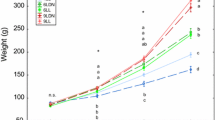Abstract
Feed intake, specific growth rate and changes in body composition were studied in juvenile (140-170 g) Baltic salmon, Salmo salar, reared at three temperatures (2, 4 and 6 °C) under continuous light conditions. Feed intake increased from 20.4 kJ kg-1 day-1 at 2 °C to 63.8 kJ kg-1 day-1 at 6 °C, and growth rate increased from 0.10% day-1 to 0.37% day-1 over the same temperature interval. The estimated lower temperature limits for feeding and growth were approximately 0.35 °C and 0.6 °C, respectively. Amongst fish reared at 2 °C the majority (86%) of the weight gain consisted of water and protein, and these fish deposited very little lipid. Lipid deposition increased amongst the groups of fish held at the higher temperatures, and amongst the salmon reared at 6 °C lipid accounted for 43% of the body energy gain.
Similar content being viewed by others
REFERENCES
Allen, K.R. (1969) Limitations on production in salmonid populations in streams. In: Symposium on Salmon and Trout in Streams (ed. T.G. Northcote) (H.R. Macmillan Lectures in Fisheries) University of British Columbia: Vancouver, BC, pp. 3–18.
Brett, J.R. (1979) Environmental factors and growth. In: Fish Physiology, Vol. VIII (eds W.S. Hoar, D.J. Randall and J.R. Brett) Academic Press: London, pp. 599–667.
Conover, D.O. (1990) The relation between capacity for growth and length of growing season: evidence for and implications of countergradient variation. Transactions of the American Fisheries Society 119, 416–430.
Cunjak, R.A. (1988) Behaviour and microhabitat of young Atlantic salmon (Salmo salar) during winter. Canadian Journal of Fisheries and Aquatic Sciences 45, 2156–2160.
Elliott, J.M. (1991) Tolerance and resistance to thermal stress in juvenile Atlantic salmon, Salmo salar. Freshwater Biology 25, 61–70.
Farmer, G.J., Ritter, J.A. and Ashfield, D. (1978) Seawater adaptation and parr-smolt transformation of juvenile Atlantic salmon, Salmo salar. Journal of the Fisheries Research Board of Canada 35, 93–100.
Fraser, N.H.C., Metcalfe, N.B. and Thorpe, J.E. (1993) Temperature-dependent switch between diurnal and nocturnal foraging in salmon. Proceedings of the Royal Society of London B 252, 135–139.
Fraser, N.H.C., Heggenes, J., Metcalfe, N.B. and Thorpe, J.E. (1995) Low summer temperatures cause juvenile Atlantic salmon to become nocturnal. Canadian Journal of Zoology 73, 446–451.
Gardiner, W.R. and Geddes, P. (1980) The influence of body composition on the survival of juvenile salmon. Hydrobiologia 69, 67–72.
Gibson, R.J. (1978) The behaviour of juvenile Atlantic salmon (Salmo salar) and brook trout (Salvelinus fontinalis) with regard to temperature and to water velocity. Transactions of the American Fisheries Society 107, 703–712.
Higgins, P.J. and Talbot, C. (1985) Growth and feeding in juvenile Atlantic salmon (Salmo salar L.). In: Nutrition and Feeding in Fish (eds C.B. Cowey, A.M. Mackie and J.G. Bell) Academic Press: London, pp. 243–263.
Hoar, W.S. (1988) The physiology of smolting salmonids. In: Fish Physiology, Vol. XIB (eds W.S. Hoar and D.J. Randall) Academic Press: London, pp. 275–343.
Jensen, A.J. and Johnsen, B.O. (1986) Different adaptation strategies of Atlantic salmon (Salmo salar) populations to extreme climates with special reference to some cold Norwegian rivers. Canadian Journal of Fisheries and Aquatic Science 43, 980–984.
Jobling, M. (1994) Fish Bioenergetics. Chapman and Hall: London, 309 pp.
Jobling, M., Christiansen, J.S., Jørgensen, E.H. and Arnesen, A.M. (1993) The application of X-radiography in feeding and growth studies with fish: a summary of experiments conducted on Arctic charr. Reviews in Fisheries Science 1, 223–237.
Jørgensen, E.H. and Jobling, M. (1992) Feeding behaviour and effect of feeding regime on growth of Atlantic salmon, Salmo salar. Aquaculture 101, 135–146.
Jørgensen, E.H. and Jobling, M. (1993) The effects of exercise on growth, food utilisation and osmoregulatory capacity of juvenile Atlantic salmon, Salmo salar. Aquaculture 116, 233–246.
Jørgensen, E.H. and Jobling, M. (1994) Feeding and growth of exercised and unexercised juvenile Atlantic salmon in freshwater, and performance after transfer to seawater. Aquaculture International 2, 154–164.
Komourdjian, M.P., Saunders, R.L. and Fenwick, J.C. (1976) Evidence for the role of growth hormone as a part of a ‘light-pituitary axis’ in growth and smoltification of Atlantic salmon (Salmo salar). Canadian Journal of Zoology 54, 544–570.
Metcalfe, N.B. and Thorpe, J.E. (1992) Anorexia and defended energy levels in over-wintering juvenile salmon. Journal of Animal Ecology 61, 175–181.
Metcalfe, N.B., Huntingford, F.A. and Thorpe, J.E. (1988) Feeding intensity, growth rates, and the establishment of life-history patterns in juvenile Atlantic salmon Salmo salar. Journal of Animal Ecology 57, 463–474.
Reinitz, G. (1983) Relative effect of age, diet and feeding rate on the body composition of young rainbow trout (Salmo gairdneri). Aquaculture 35, 19–27.
Robertson, O.H. (1948) The occurrence of increased activity of the thyroid gland in rainbow trout at the time of transformation from parr to silvery smolt. Physiological Zoology 21, 182–295.
Shearer, K.D. (1994) Factors affecting the proximate composition of cultured fishes with emphasis on salmonids. Aquaculture 119, 63–88.
Sokal, R.R. and Rohlf, F.J. (1981) Biometry (Second Edition). Freeman and Company: San Francisco, 859 pp.
SYSTAT (1992) SYSTAT for Windows: Statistic, Version 5 Edition. SYSTAT Inc: Evanston, IL. 750 pp.
Talbot, C. and Higgins, P.J. (1983) A radiographic method for feeding studies on fish using metallic iron powder as a marker. Journal of Fish Biology 23, 211–220.
Virtanen, E. and Forsman, L. (1987) Physiological responses to continuous swimming in wild salmon (Salmo salar L.) parr and smolt. Fish Physiology and Biochemistry 4, 157–163.
Author information
Authors and Affiliations
Rights and permissions
About this article
Cite this article
Koskela, J., Pirhonen, J. & Jobling, M. Effect of low temperature on feed intake, growth rate and body composition of juvenile Baltic salmon. Aquaculture International 5, 479–488 (1997). https://doi.org/10.1023/A:1018397014684
Issue Date:
DOI: https://doi.org/10.1023/A:1018397014684



